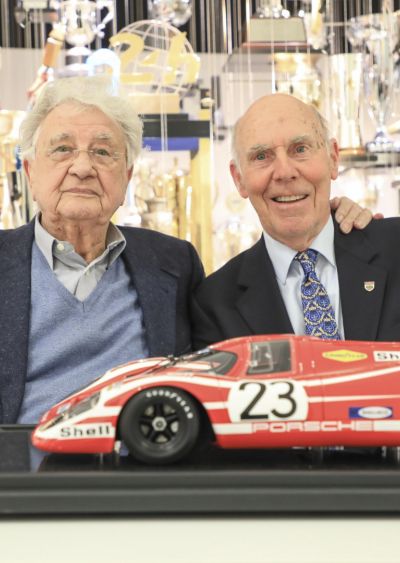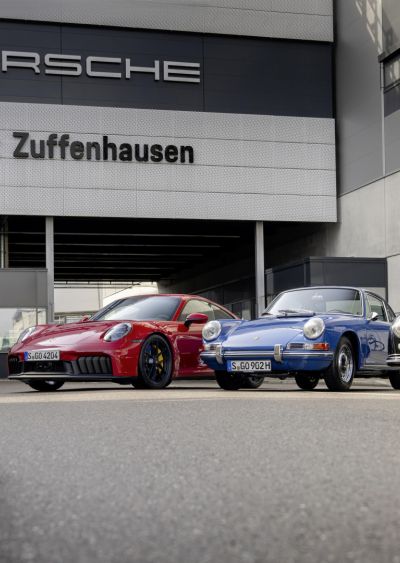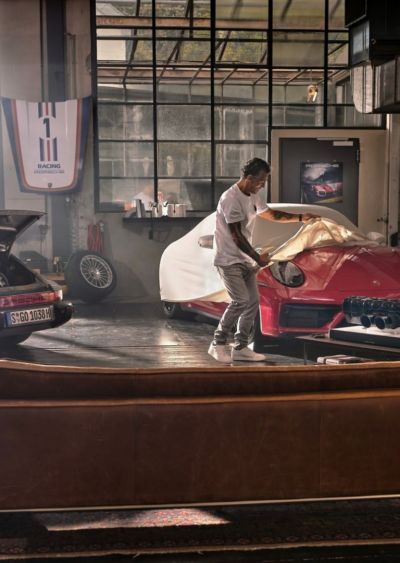Chassis Number: 83727
Engine Number: P90897
Colour: Ruby Red 5702 (Original)
Interior: Black (Original)
Drive: Right Hand Drive (Original)
UK Registration Number: 426 YUJ
The combination of the stylish Speedster coachwork with glorious four-cam Carrera motor, as seen here has long been regarded by enthusiasts as Porsche’s ultimate expression.
BACKGROUND TO THE CARRERA SPEEDSTER
Constant development saw the 356’s engine enlarged first to 1.3 and then to 1.5 litres; the original split windscreen replaced by a one-piece; and a Porsche synchromesh gearbox adopted. A cabriolet followed hot on the heels of the original 356 coupé and then in 1952 a trial batch of 15 roadsters was constructed at the behest of US importer Max Hoffman, who had persuaded Porsche of the potential for a ‘cut-price’ entry-level model.
The roadsters’ successful reception in the USA led to the introduction of the Speedster model in 1954. The Speedster’s inspiration is also credited to John Von Neumann, Porsche’s West Coast distributor, who had chopped down a Gmünd-built coupé in the late 1940s to create a lightweight competition car. Explaining such a car’s appeal Neumann once said: ‘Guys want to go, on a Saturday night in June, down Sunset Boulevard with their elbow over the door and the girls can see them in the car.’
Instantly recognisable by virtue of its low, wraparound – as opposed to V-shaped – windscreen, smaller and entirely retractable hood, lower door waistline, horizontal trim strip at the level of the door handles, and twin bucket seats – all of which served to emphasise its sporting image – the Speedster was, in effect, an ‘economy’ model intended to compete with the cheaper British sports cars.
The Speedster was powered initially by the 1.5-litre version of Porsche’s horizontally opposed four, gaining the new 1.6-litre, 60bhp engine with the introduction of the improved 356A in 1955. Priced at $2,995, the Speedster was the lightest of the 356s, enjoying a commensurate performance boost that meant over 100mph was possible. Allied to it’s already renowned handling characteristics, this meant that the Speedster was an instant success in the burgeoning American sports car racing scene.
STARS IN SPEEDSTERS!
In February 1955 James Dean took possession of a new 1955 Porsche 356 Super Speedster. In September 1955 Jimmy traded in his Porsche Speedster and bought a 1955 Porsche 550 Spyder. Jimmy had Dean Jeffries paint his provisional race number, 130 painted on the hood, the doors and the rear deck lid. He also had Jeffries personalize the Porsche by painting a nickname, “Little Bastard” on the tail.

Testing the Speedster alongside its Coupé sibling in 1956, Road & Track magazine declared, ‘A more comfortable sports car for long, high-speed journeys would be very hard to find and certainly, no other car achieves the combination of comfort, performance and fuel economy of the Porsche Continental Speedster or Coupé.’ Its combination of style, performance and value for money made the Speedster deservedly popular – 4,822 examples being constructed between 1954 and ’58 – and today this most handsome of the 356 variants enjoys iconic status.
The evocative ‘Carrera’ name first graced the flanks of a Porsche in 1955. Applied to a 356A powered by a slightly less ferocious version of the racing 550 Spyder’s 1.5-litre, twin- overhead-camshaft, roller-bearing engine, it had been adopted to capitalise on Porsche’s victories in the Carrera PanAmericana in 1952 and ’54. Dry-sumped like the racer’s, the four- cam Carrera engine produced 100bhp, some ten horsepower fewer than in race trim.
Ferry Porsche and the famous Ernst Fuhrmann’s 4 cam engine

Nevertheless, this was good enough to propel the 356 Carrera to over 120mph, making it the fastest 1.5-litre production car of its day and a formidable racetrack competitor. Significant developments included a capacity increase to 1.6 litres in 1958 and the adoption of a plain- bearing crankshaft at the same time.
Back in ’57, Car & Driver enthused about the new Carrera: ‘If there was ever any doubt in your mind about what constitutes a sportscar, take a long look at this new Carrera; it fits anybody’s definition. Not only is it capable of winning its class hands down on a Sunday afternoon airport race, it will pack two kids and bags of groceries from the neighbourhood store almost as easily as the family sedan, and you’ll have a whole lot more fun in the process. But don’t misunderstand, for the new Carrera was designed to GO first and to transport kids second.’
EARLY HISTORY OF CHASSIS NUMBER ‘83727’
Chassis number ‘83727’, is the last of only three right-hand drive Carrera Speedsters built by Porsche out of a total production of 152 cars. All three were delivered to Australia. The first two cars built were ‘82459’, completed on 11th July 1956, and ‘83558’, completed on 5th July 1957. Both cars are still in Australia.
‘83727’ was built on 3rd September 1957 finished in Ruby Red with black interior, Rudge wheels, US bumpers, 1500 GS engine (number ‘P90885’) and gearbox number ‘16113’. The Porsche was delivered new to Irvin Rockman, a wealthy Australian hotelier. In 1958, Ken Tucker, a 356 collector, purchased the car from the O’Neill family via Diesel Motors (when it was registered ‘RO000’) and reregistered it as ‘BNV 333’. Ken sold the car a few years later to Australian yachtsman and Porsche enthusiast, Warwick Miller.
In the mid-1960s, Dr Edwards of the Royal Melbourne Hospital bought the car and ran it with a 1600N overhead-valve engine, selling it to Gary Rigg when he returned to Canada in 1970. The fate and whereabouts of the original engine are not known. The fact that the Carrera Speedster was intended primarily for competition has resulted in few retaining their original engines, as at the time it was cheaper to replace them than rebuild them.
Gary Rigg owned the Porsche until 1982 and then sold it to Trevor Keetly. Intending to race the car, Trevor restored it as a GT and installed engine number ‘P90897’, which he had bought in the USA. That engine belonged to chassis number ‘83794’, the fourth GT Speedster off the production line. Other GT upgrades included 60mm front brakes, 80-litre fuel funk, Sebring exhaust, roll bar, Spyder wing mirror, wide steel wheels, GT bumper trim, and a Derrington wood-rim steering wheel. The original gearbox, which was retained, was rebuilt by Charles Appel, and the engine by Rennsport International USA.
The car was purchased by a UK Porsche collector in November 2011. There was very little information available on the kardex so the new owner embarked on an information gathering exercise.
Mike Smith of PR Services while on a trip to the factory looked at the Reutter Book build codes. It established that the car was Ruby Red with Black vinyl seats, Oatmeal carpet, White hard top and a black vinyl tonneau cover. Steve Heindrichs in his books “Porsche Speedster Type 540” confirmed it was an original Right Hand Drive car.
Photos of the car in 1959 showed it with side spears, rudge wheels, U.S. Bumpers and fog lights not listed on the build sheet.
The below picture shows the car prior to restoration.

In March 2013 the new owner was anxious to get the car back to as original as practical while maintaining the GT upgrades. He employed the services of Classic Porsche restorers Sportwagen and Maxted-Page & Prill Ltd to undertake the restoration.
Blasting the chassis revealed heavy lead filler used to build the extremities of panel edges and fill low areas and where repairs did not follow the correct shape of the body. A full restoration was the only option with a car of such value.
The outer panel work was removed and rebuilt as necessary followed by repairs of the internal panel work. Localised repairs were feasible in most case so no panels needed replacement. To further the GT upgrade a louvred engine cover with air boxes completed the restoration in 2013.
Between 2012 and 2014, chassis number ‘83727’ was returned to its original Ruby Red livery, black leather seats with corduroy inserts. Adding to the GT upgrades, a louvred engine cover with air boxes was also fitted.In total, some £100,000 was spent on the restoration.

CONCOURS WINNING CAR
Over the past 25 years Chassis number ‘83727’ has been awarded first as several of the world’s premier events. In Australia, the car had won the 356 Registry Award for 1992, 1993, and 1994 and the Inaugural Master Class award in 1996. In 2014, ‘83727’ won the ‘Best of the Show’ award at Hedingham Castle Porsche Classic event.
In September 2018 ‘83727’ was entered into the Salon Prive 70th Anniversary Porsche Concours winning three first place awards including the Best Open Top Car, Best Engine and the coveted Duke of Marlborough Best Car in Show!
This car has also featured in several publications, namely Australian Classic Car Yearbook (2004), Christophorus magazine (January 2006), Unique Cars (November 2006), Precious Cars (Autumn 2006), Motor (December 2006) and Just Cars (January 2007). Classic Porsche Magazine will be running a seven page featured in Issue 58 (December 2018).

Article re-published from Export 56.com web page







